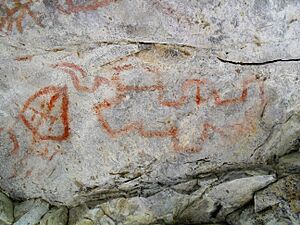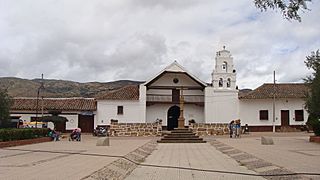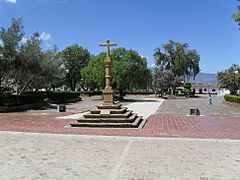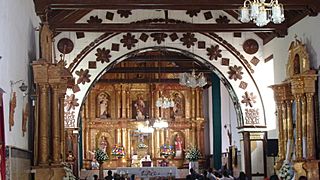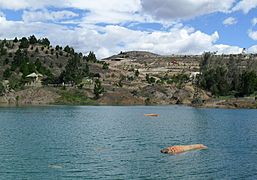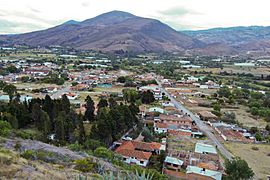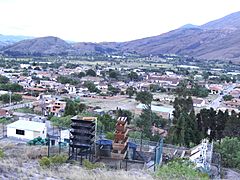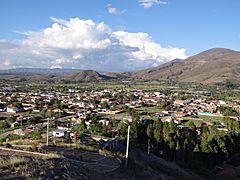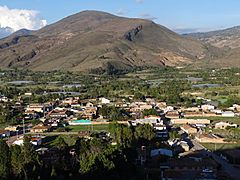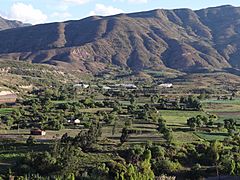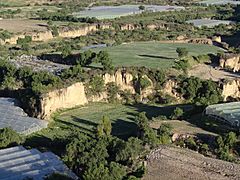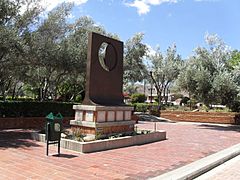Sáchica facts for kids
Quick facts for kids
Sáchica
|
|||
|---|---|---|---|
|
Municipality and town
|
|||
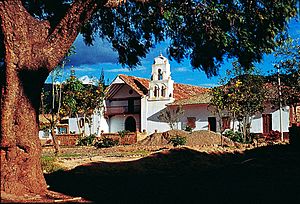
Church of Sáchica
|
|||
|
|||
| Nickname(s):
City of onions
|
|||

Location of the municipality and town of Sáchica in the Boyacá Department of Colombia
|
|||
| Country | Colombia | ||
| Department | Boyacá Department | ||
| Province | Ricaurte Province | ||
| Founded | 16 July 1556 | ||
| Founded by | Juan Velasco and Carlos Rojas | ||
| Area | |||
| • Municipality and town | 62.4 km2 (24.1 sq mi) | ||
| Elevation | 2,150 m (7,050 ft) | ||
| Population
(2015)
|
|||
| • Municipality and town | 3,791 | ||
| • Density | 60.75/km2 (157.35/sq mi) | ||
| • Urban | 1,875 | ||
| Time zone | UTC-5 (Colombia Standard Time) | ||
Sáchica is a town and municipality in Colombia. It's about 34 kilometers (21 miles) west of Tunja, in the Boyacá region. Sáchica is famous for its onions and is even called the "national capital of onions." It shares borders with towns like Sutamarchán, Villa de Leyva, Chíquiza, Samacá, and Ráquira.
Contents
History of Sáchica
Before the Spanish conquistadores arrived, Sáchica was led by a local chief called a cacique. This chief was loyal to the zaque (a powerful ruler) of Hunza.
Ancient Muisca People
Scientists have found signs that people lived here for a very long time. They found petroglyphs, which are drawings carved into rocks. These were made by the Muisca, who were part of a large group called the Muisca Confederation.
The Muisca had their own religion. Their main gods were Sué, the Sun, and Chía, the Moon. In Sáchica, there are monuments built to honor both the Sun and the Moon.
Founding of Modern Sáchica
Modern Sáchica was officially started on July 16, 1556. It was founded by Juan Velasco and Carlos Rojas. In 1574, about 2,500 native people lived in Sáchica. Today, only a small part of the population is indigenous. Most people are mestizo, meaning they have mixed heritage.
The name Sáchica comes from the Chibcha language of the Muisca. It can mean "our present domain," "fortress," or "mansion of the sovereign."
Rock Art in Sáchica
In a rock shelter in Sáchica, amazing rock art has been found. These are called pictographs, which are paintings on rocks. Eliécer Silva Celis, an archaeologist, was one of the first to study them in the 1960s.
Later, other researchers like Carl Henrik Langebaek and Diego Martínez also studied these artworks. The rock art is black, red, and white. It shows human faces, Suns, corn, eyes, mountains, masks, and other shapes. These paintings are found in rock shelters made of old rock formations.
Ancient Animals: Paleontology
Sáchica is also famous for its ancient animal discoveries.
Sachicasaurus Vitae
Scientists found a fossilized skeleton of a huge sea reptile called Sachicasaurus vitae near Sáchica. This animal was almost 10 meters (33 feet) long! It lived during the Lower Cretaceous period. The name Sachicasaurus means "Sáchica lizard," and vitae means "life." This name was chosen because the fossil brought new life and excitement to the village. Even though it was very big, the Sachicasaurus found was not yet fully grown.
Kyhytysuka Sachicarum
Another ancient sea reptile, an ichthyosaur named Platypterygius sachicarum (now called Kyhytysuka sachicarum), was also found in the area. It was discovered in the Paja Formation near Villa de Leyva. This animal was also named after Sáchica.
Economy of Sáchica
The economy of Sáchica is based on a few main things:
- Religious Tourism: Many people visit Sáchica for its religious sites.
- Agriculture: Farmers grow crops like onions and tomatoes. Sáchica is especially known for its onions.
- Mining: The town also mines for materials like gypsum, marble, and clay.
Gallery
See also
 In Spanish: Sáchica para niños
In Spanish: Sáchica para niños





